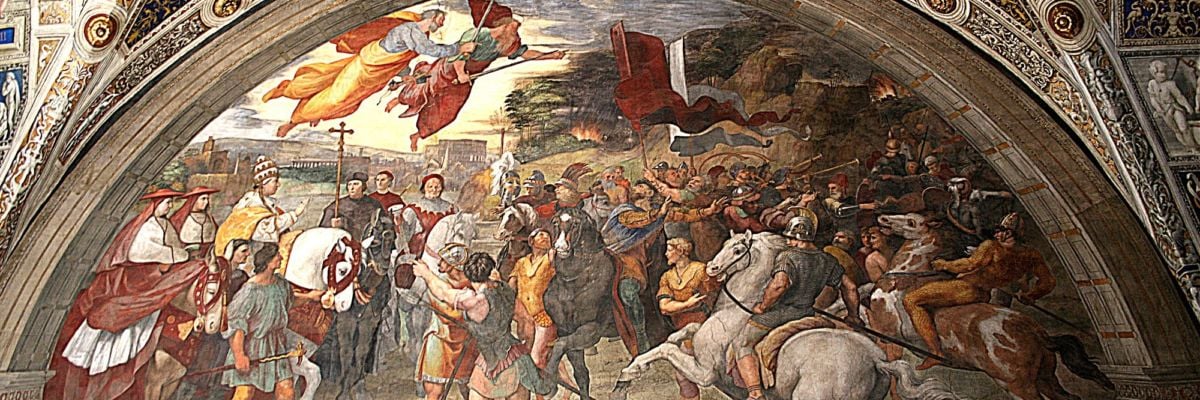
The year 452 brought a shadow out of the East that lengthened over Rome. Attila the Hun was coming, and the earth trembled beneath his tread. His barbarian horde had been scorching Italy, leaving death and devastation in their wake. Cruel in torture, ravenous in plunder, and boundless in arrogance, the Hun, called the Scourge of God, razed and ravaged and rushed upon Rome.
But as Attila loomed before the Eternal City, there came to meet him not an army, but a man. Out from the ancient gates of Rome passed a white-haired ancient in bishop’s raiment. The aged pope of Rome hobbled forth to hold conference with the wild Hun while the city waited and watched. A feeble old man prepared to save his flock.
There is reason why this pope was the first to be called Great.
Pope Leo the Great held the chair of St. Peter from 440 to 461. From there he proclaimed the elect holiness of Rome in a shift from the riches and renown of Constantinople as the center of Christendom. Leo called Rome a royal city and, by virtue of the See of St. Peter, the heart of the Christian world. “Though enlarged by many victories, you have spread the authority of your rule over land and sea,” he said of the city and its empire. “What your warlike labors have attained for you is less than what the Christian peace has brought you.” Leo ruled Rome and the Church with moral faith and religion rather than military force and dominion.
With assertive strength as the supreme pontiff, Leo was a theological force. In 451, he gathered the largest group of bishops in history for the Council of Chalcedon—a council to muster strength and strategy against a wave of heresies arising from the East. Leo took up the destiny of the Church with a will that evoked a rare and robust trust in God and with such broadness of vision that he is remembered not only as a guardian of the Faith, but also as a savior of Western civilization.
At the Council of Chalcedon, the existence of Jesus Christ’s dual nature in one divine person was defined and dogmatized in Leo’s magnificent epistle, called the Tome, which was read aloud at the council. Upon this inspired articulation of the hypostatic union, the bishops reported, “Behold, this is the Faith of the Fathers. This is the Faith of the apostles. This we believe. Peter has spoken through Leo.”
Although the council solidified truth within the Church, it also poured fuel on the smoldering fires of the East, where many bishops were yet chafing under the rise of Rome over Constantinople and resisting orthodox teaching with heresy and schism. Pope Leo rejected the attempts of the East to push its errors upon the universal Church. The subsequent rivalry between Constantinople and Rome led to violent uprisings and the persecution and martyrdom of holy bishops in Alexandria and Egypt.
But neither mobs nor militia could deter Leo. He proved an inflexible adversary of heresy and gave instruction and assistance to the reeling government in Constantinople to suppress religious rebels. In the end, the imperial battalions were fortified, and the heretics were overthrown.
Leo’s indomitable spirit and incisive mind have ever continued to influence and inform the Roman Catholic Church throughout the centuries after his death on November 10, 461, when he was buried, according to his wishes, as close to the bones of Peter as possible. His sermons and Christological writings have been read for well over a thousand and a half years on the most beautiful and signal feasts of the Faith: Christmas, the Epiphany, Pentecost, and the Ascension.
Leo was a regal saint, a doctor of the Roman Church, a kingly pope serving the King of Kings who shone out with the glory of God’s power. But on that day when he met Attila the Hun, Leo showed how meekness can be the mightiest of heaven’s tactics.
According to pious legend, Pope Leo stood before Attila the Hun outside Rome and said these words:
The people of Rome, once conquerors of the world, now kneel conquered. We pray for mercy and deliverance. O Attila, you could have no greater glory than to see suppliant at your feet this people before whom once all peoples and kings lay suppliant. You have subdued, O Attila, the whole circle of the lands granted to the Romans. Now we pray that you, who have conquered others, should conquer yourself. The people have felt your scourge. Now they would feel your mercy.
So spoke the venerable bishop under the tyrant’s gaze. Then, suddenly, Attila’s incredulous eyes beheld two giants flanking the pontiff, one on his right and the other on his left. The apostles Peter and Paul appeared, wielding swords of flame over the gray head of the pope, who knelt in an attitude of humble submission.
The invader recoiled. There arose in his vision a gleaming, glorious army, ten thousand times greater than his own, ranked in row on row of flashing fire against the night sky, hovering over the city, flaming weapons at the ready.
The pope’s plea echoed in Attila’s ears like a command. The Hun raised Leo to his feet, swore to an enduring truce, and retreated with his legions across the Danube.
There is a greatness proper to those who are humble enough to put their faith in the invisible powers of heaven, for it is then, at such demonstrations of faith, that those powers become visible. St. Leo was a man of great faith, which is precisely why he is remembered as “the Great.”
Image: Raphael’s “Meeting of Leo the Great and Attila,” fresco, 1514.



